Bow Hunting Elk 101: [Beginners Guide]
By Bill Bernhardt |

Elk hunting is one of the most popular big game animal hunts in the nation. But finding one of these majestic creatures, taking it down and harvesting it can be challenging even for an experienced hunter with a high-power rifle. Hunting an elk with a traditional or compound bow takes the challenge to a whole new level and requires a higher-level of skill and training. Below we’ll explore some tips and tricks I’ve learned over the years to greatly improve your bow hunt and greatly increase your chances of bringing home a trophy elk.
Scouting Elk Habitat
When most avid bowhunters think of eastern big game hunting, they tend to automatically think of hunting whitetail deer because whitetail is the number one eastern large game species. However, when those same hunters think of western big game hunting, they instead tend to envision the majestic Elk with its much larger body size and its larger rack. But, because the terrain and food sources differ so widely between the East and the West, bow hunters in the West employ different tactics to scout and locate elk than hunters use in the East for whitetail deer hunting.
Scouting western elk habitat is actually somewhat easier than scouting eastern whitetail deer habitat because of its open terrain and because most western states limit hunters to a given Game Management Unit or "parcel". Since hunters targeting Elk in the west know that they will be hunting in a given geographical area, the first step is start scouting by looking up the parcel online using Google Earth. Although this tool is not specifically designed for hunters, it is nonetheless one of a western hunter's best buddies.
By providing you with an aerial overview of your parcel, Google Earth enables you to examine the parcel's terrain before ever setting foot on it by either zooming out to view the entire parcel or by zooming in to examine a terrain feature such as a watering hole or an elk heard in great detail either on your computer at home or your phone in the field. Thus, viewing your parcel from above will enable you to find areas where elk like to congregate to feed, drink water, and bed as well as determining the travel routes between these areas.
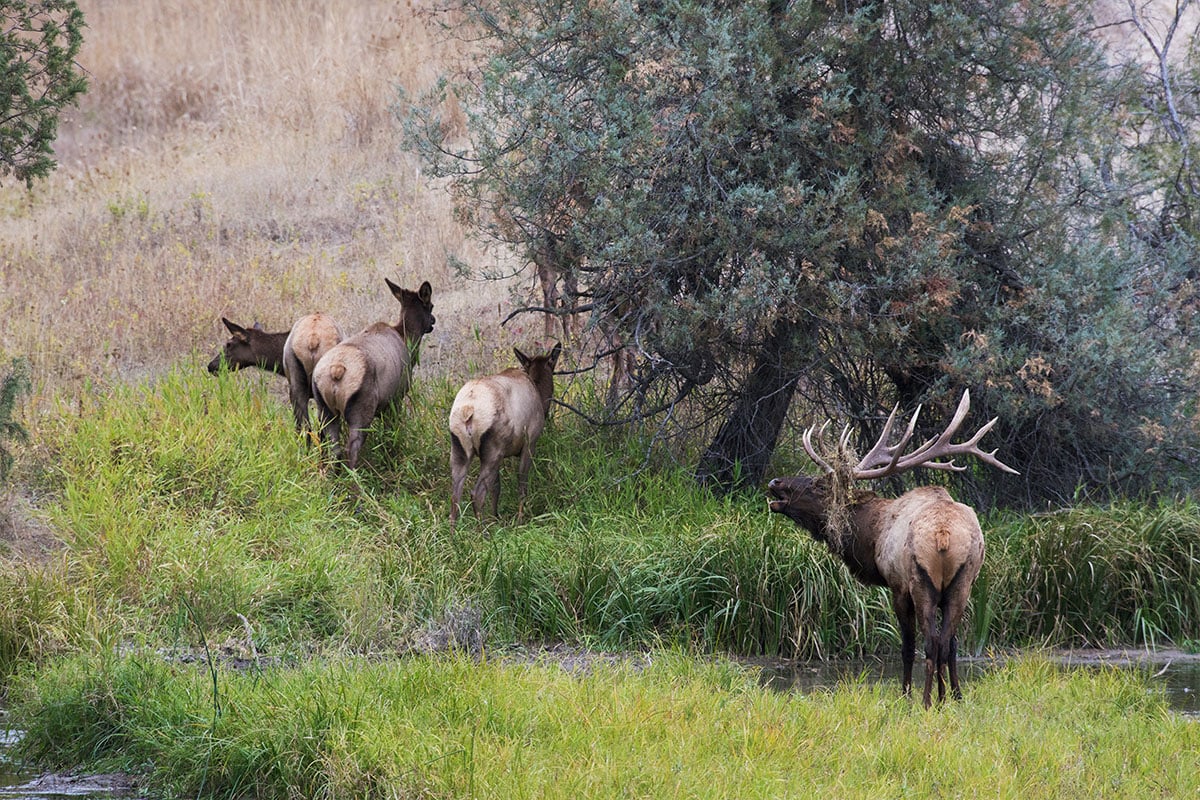
Unfortunately, there is no simple formula for determining how long you should spend glassing any given area before moving on to what may prove to be a more productive location and thus, deciding how long to spend evaluating any given area eventually becomes a matter of intuition.
When evaluating a parcel or terrain to determine if its going to be good for elk hunting using a bow remember that like most game animals, elk have three basic needs: food, water, and shelter. I recommend looking for the following terrain features and characteristics if you want to really find where the elk are hiding out.
- Benches - Elk like steep country, not for the same reason as mountain goats who thrive on the steep slopes, but more to provide cover and escape from hunters and other predators
- Saddles - Unlike whitetail deer, elk tend to be grazers not browsers. This means they forage for food that grows in flatter, low-lying areas where the soil is nutrient rich. This soil collects in bowls and saddles. A saddle is typically found at the low point where two ridges come together. At dusk and dawn you’ll often find elk feeding on the growth in these saddles. Elk will also use saddles to traverse form one ridge to the next, and during rutting season elk herds will often congregate in saddles.
- Bowls - You’ll often find elk hanging out in bowls, much as you would a saddle. Bowls are small flat valleys high in the mountains surround by ridges or peaks. They often have wallows and patches of timber scattered throughout, with ample food supply. Elk love bowls. Bowls are often hard to spot form below, so using a program like Google maps can help you identify if there are any bowls in they area you’ll be hunting. Find a bowl with green grass, water and cover, and you’ll likely find some elk.
Google Earth is truly an indispensable tool for western elk hunters, but it's no substitute for seeing and exploring your parcel in person. Thus, once you have a good idea of where the elk like to feed, water, and bed and the routes that they use to travel between these areas, the next step is to go out and see them in person.
Locating Elk
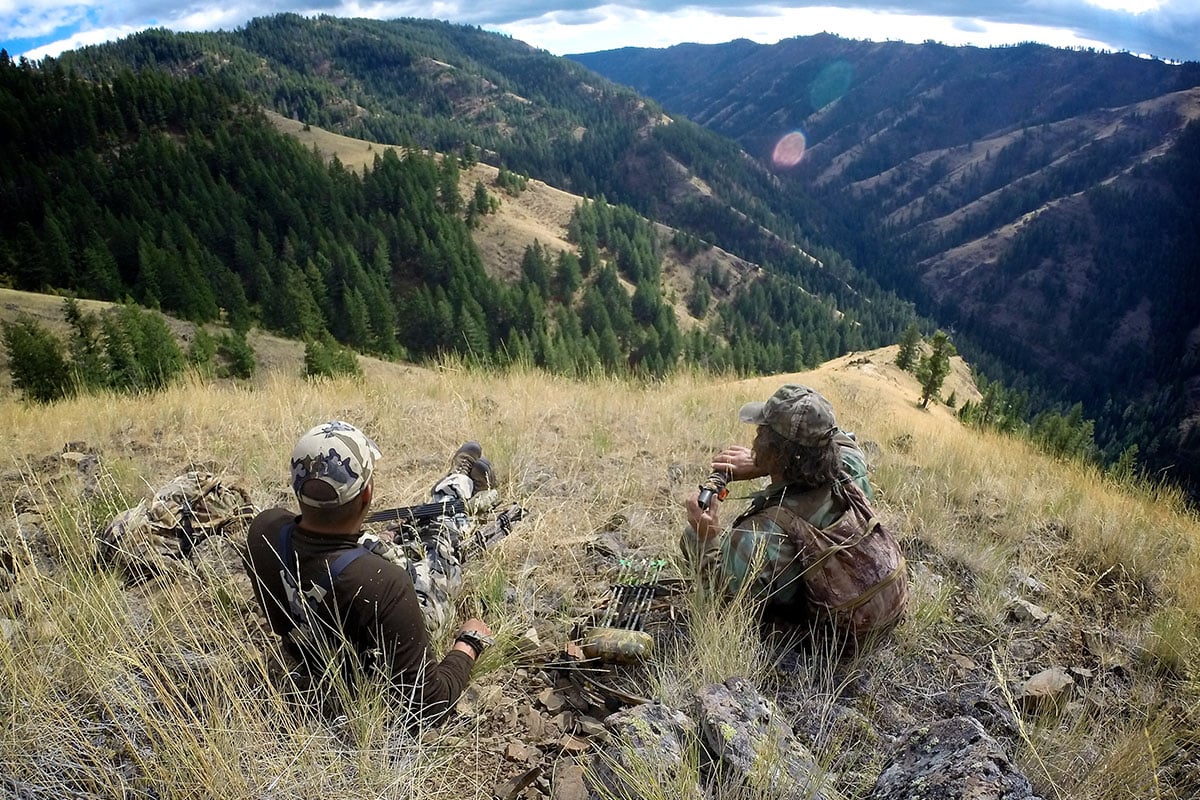
Unlike eastern whitetail deer hunting which is done either by stand hunting, blind hunting, or by tracking in the northern states during winter, western elk hunting is most often done using the spot-and-stalk method due to the open terrain. But, there are some species of elk that prefer to inhabit woodlands instead of open terrain and thus, these elk must often be hunted using the tactics of the eastern whitetail deer hunter rather than those of the western elk hunter. Nonetheless, in order for a bow hunter to stalk an elk, they must first spot one and this is generally done by "glassing".
In order to surveil or "glass" an area where you believe that one or more elk might appear, a high-resolution spotting scope is an absolutely essential item. In addition, most western elk hunters also carry a pair of high resolution, high power, binoculars for use when on the move. Once you have the proper optics for the hunt, you will need to locate an elevated vantage point that will provide you with broad view of the entire area and which is far enough away that an errant breeze won't carry your scent to the elk and spook them. Then, you will need to use your spotting scope to surveil the area you where you expect to see the elk and simply wait for them to come within range.
Unfortunately, there is no simple formula for determining how long you should spend glassing any given area before moving on to what may prove to be a more productive location. These decisions rely on a hunter’s intuition, which is developed over time.
Stalking an Elk
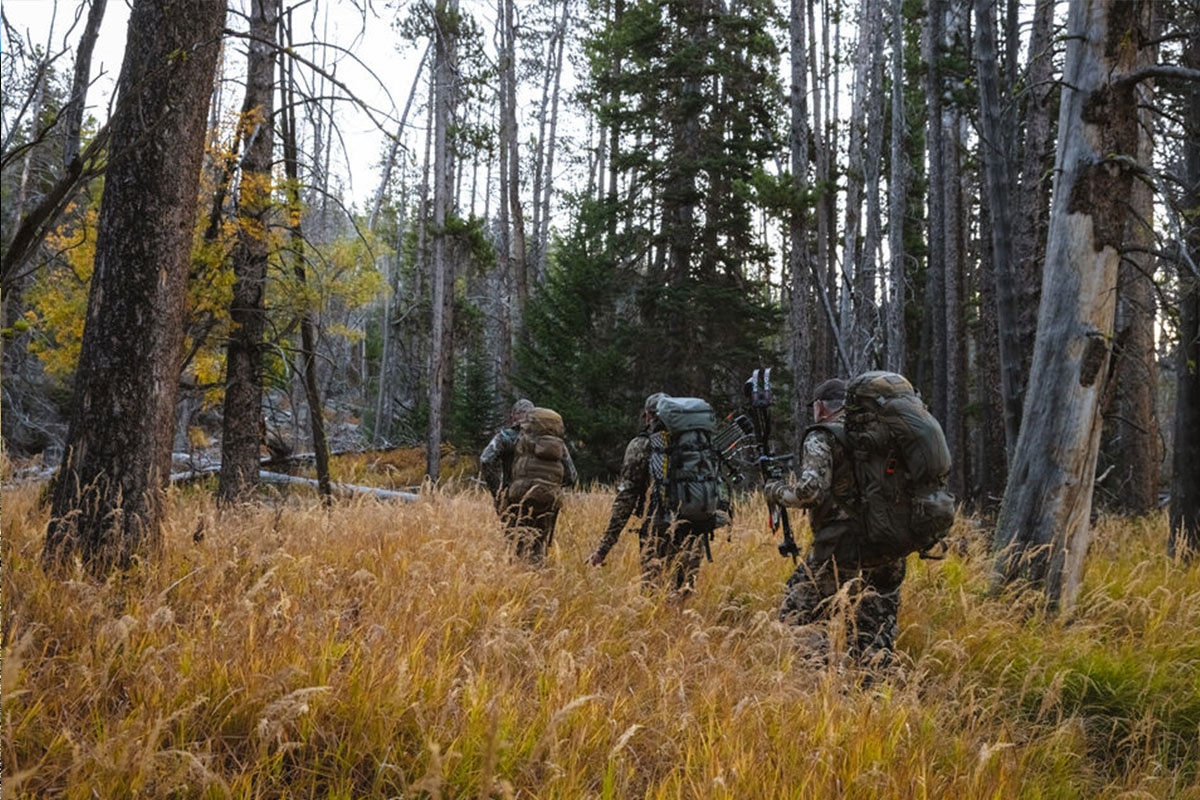
Once you have spotted a mature bull elk and made the decision to stalk and shoot him, the hunt truly begins! However, stalking is as much an art as it is a science. It’s a skill that can only be improved with time and practice. The goal of stalking an elk is to plan a route to the animal that allows you descend from your elevated observation post without being seen by the elk. Of course, that includes not standing up and silhouetting yourself against the skyline and not barreling off down the hill or mountain you are perched on straight at the elk unless you have enough cover to conceal your movements.
Ultimately you want to get as close as possible to the elk, so you can get off a clean, safe shot. Most eastern bowhunters of whitetail deer don't take shots longer than 30 yards and many eastern bowhunters prefer shots of 20 yards or less. However, for a bowhunter of western elk, a 30-yard shot is a close range shot and thus, you should be prepared to take shots as long as 70 or 80 yards. Of course, this requires a bow with a relatively heavy draw weight as well as a relatively heavy arrow and broadhead combination in order to gain sufficient penetration to humanely harvest the animal at those ranges but, I will discuss this in greater detail in a later section.
When moving in a bull elk paying attention to the following help detail will help you close the distance without advertising your presence and get you in close enough for successful kill shot.
- Understanding Basic Elk Behavior – Thousands of years of evolution have helped the elk develop an uncanny ability to detect danger. Their patterns and behavior can vary from day to day, but understanding some basic behavior will help you get close enough to these grand creatures to get off a clean shot.
- Scent - Elk have an exceptionally sensitive sense of smell, and your stalk can be prematurely ended if they catch your scent. Make sure to approach the elk from downwind. You can always wet your finger in your mouth and hold it up to see which side is cooler – but I prefer using a tool specifically designed to detect wind direction.
Great for Wind Checking:
For instance, the tool that I use consists of a small, pliable, plastic, tube filled with a lightweight fiber. It has a ring to attach to the shoulder strap of my backpack, so I can easily reach it. I grab a small bit of the fiber that protrudes out of the hole on the side of the tube, and pull it out and then release it to see which direction it floats in.
Another simple, inexpensive, effective tool is a small plastic squeeze bottle filled with flour. When you want to know the direction of the wind, you can simply squeeze a bit of flour from your bottle into the air and see which way it floats.
Be aware that wind acts like a liquid when its moving and thus, in that it has eddies. Consequently, it can literally change direction in an instant. So, although the wind may be blowing in a given general direction, it may very well swirl and carry your scent to the elk at any time!
Great Scent Blockers:
Wind also changes direction vertically depending on the time of day. For instance, because cold air is more dense than warm air, the air surrounding the mountains and hills sinks down their faces and pools in the valleys during the night and throughout the early part of the day. But, once the sun warms the valleys enough to heat the air in them, the flow will reverse direction and the air will start to rise up the face of the hills and mountains during the latter half of the day. Thus, you can expect your scent to be carried downhill during the morning and uphill in the afternoon.
Remember, if an elk smells you, it’s over. They have a very sensitive nose and 99% of the time he’ll bolt. If he doesn’t bold immediately, he’s now on high alter to your presence and it will no be a lot harder to get closer without him noticing. Sometimes the wind direction will change in mid-stalk and force you to back up and come in at a different angle. You can fool an elk’s eyes and hears, but not his nose. Scent will give you away, so be careful and do what you must to not let him smell you.
- Sound – While not quite a sensitive at their sense of smell, elk still have excellent hearing. You need to pay close attention to the sounds you do and don’t make when stalking an elk. You don’t always need to be perfectly quiet, but you do need to pay close attention to when and how you make sound. Elk are large, loud creatures. When they walk, they’re loud. If they’re moving loudly, you can too. But when an elk is quiet, any sound you make may spook them. The quieter you can be, the better.
- Cover – You want to use cover to your advantage when stalking an elk. Cover will allow you keep out of an elk’s sight. It will also help cover your scent. When considering cover, I highly recommend using an adjacent drainage when available to make your way toward a warry elk. A drainage will hide you from sight, it will muffle any sound you may make, and it will also allow your scent to travel down the drainage and not be carried toward the elk’s location.
If there aren’t any drainages or ditches that can provide cover, using trees or vegetation is your next option. The key is to try and keep enough cover in between you and elk to allow you approach undetected and as quickly as possible. - Speed – We often think of stealth, silences and slow movement as the hallmarks of the stalk. But sometimes an effective elk stalk requires you to run and move in quickly paying more attention to covering as much ground as possible paying less attention to sound and scent. Given the right conditions, sound and scent will be masked in which case getting in near the elk herd before they move or bolt is key.
Many a time I’ve run down an adjacent drainage or around the back side of hill to head off heard before it moved out of shooting distance. When you get within about 100 yards of your quarry it’s time to slow down your pace and use more traditional stealth tactics for closing the distance.
Again, when you’re close enough to spot the elk, you will need to go into stealth mode. Drastically, slow your approach and keep your footsteps both erratic and as quiet as possible. Next, you will need to plan your final approach by observing the available cover between you and the elk while also noting whether or not he is moving and, if so, what direction he is moving in. Then, if there is enough cover available, you will need to start your stalk and hopefully you will be able to approach the elk close enough to get a shot. However, if you lack sufficient cover to allow you to approach to within a comfortable shooting distance for you, then you might want to halt your stalk and wait for the elk to move into a more favorable position before continuing.
Elk Calls
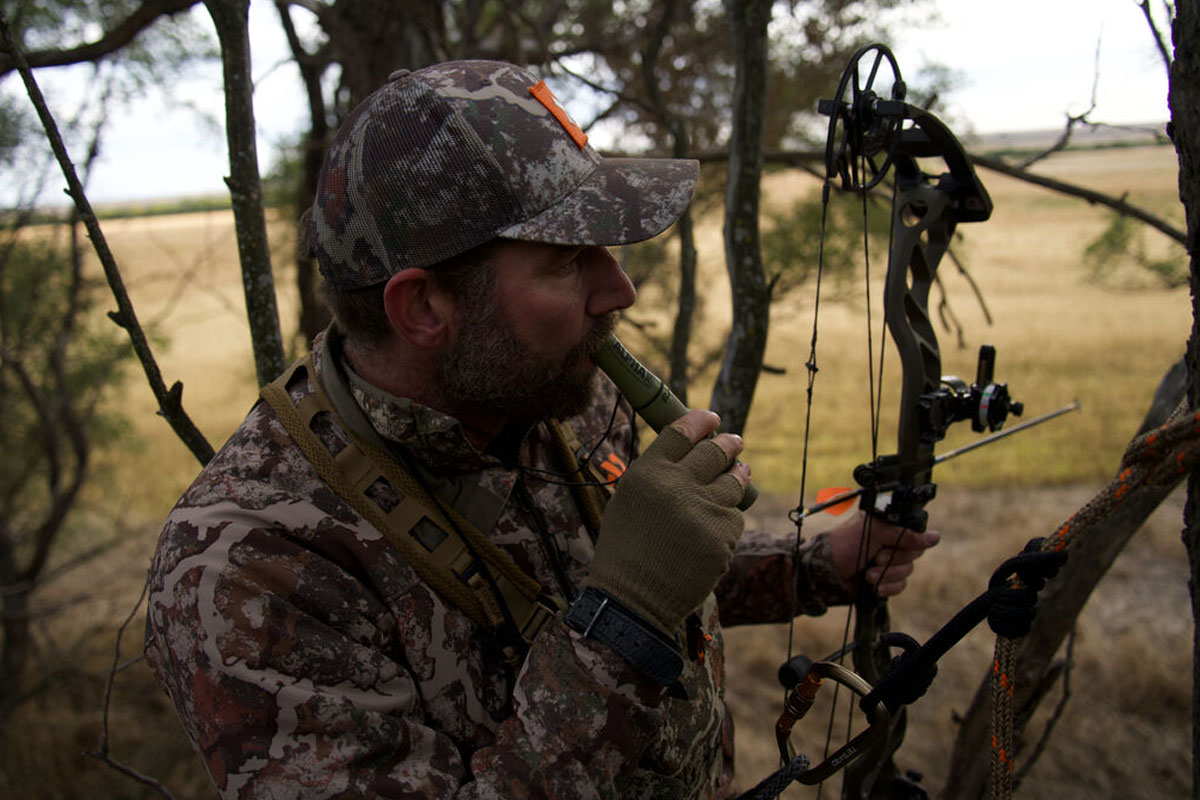
Fortunately, spending hours sitting on a hilltop or the side of a mountain glassing the terrain below you are not the only ways to get within shooting distance of an elk. Many western elk hunters will carry a bugle call with them when bowhunting elk to bring elk to them. This type of call is specifically designed to mimic the bugle of a mature male elk which you can use during the rut to attract a female elk as well as issue a challenge to other mature males in the vicinity. Using a bugle call, you can often draw the elk to you instead of having to locate and stalk him.
An elk call can serve two purposes. First, you can use an elk call as a locator call just like you would when hunting wild turkeys in the East. Second, you can use an elk call to draw a bull elk to you just like you would when using a deer call to draw in a whitetail deer.
To use a bugle call as a locator call, all you need to do is emit one long, loud, bugle and then perhaps follow it up with series of three or four short blasts and wait a few seconds to see if you get a reply. If don’t get a reply, then you can try bugling again. If a bull elk does reply, then note the direction of the reply and move toward it.
To a bull elk, a bugle from another bull elk is a challenge to his breeding opportunities and thus, it tends to get them fighting mad. So, depending on how far away from you he is, he may very well come running to your call and be in a mood to fight when he gets there so be prepared! Of course, this is exactly what you want to happen when attempting to use a bugle call to draw an elk within bow range. But keep in mind that elk are very wary animals and if they see you as they approach, they will spook and bolt. It’s extremely important for you to find a hiding spot that provides sufficient concealment before you attempt to draw an elk with a call.
Bow hunting season for elk is usually set right around the rut when elk are most vocal and most lightly to respond to a call. So take the time to practice your calls if you want to improve your chance of getting close enough to a large elk to take him down with a bow.
The following are the basic elk vocalizations you should be familiar with:
| Elk Vocalization | Description | Application |
|---|---|---|
| Bugle | This is a loud, well known, unmistakable elk call like a bugle. Used by bull elk to show dominance and locate other elk. | Great way to call elk to locate bull elk during rut or call a bull elk to your location. |
| Chirps | Is made when other elk are nearby. This would be like a group of elk chatting with one another. | Use this call to give the impression of large group of cow elk. Can be used to attract a bull elk. |
| Mew | Sound made by a cow elk when communicating (sometimes when she is ready to breed). Sounds like a whine. Lower pitched than a bugle but similar. | Can be used to attract bull elk. |
| Barks | Common vocalization that sounds like a bark. Pointed and abrupt. This is an alert call. | You should recognize this call but never use it. |
| Chuckle | Series of grunt sounds followed by a bugle. Communicates dominance. | Can be effective for calling out and drawing territorial bull elk to your location. |
| Elk Call | Description |
|---|---|
| Bugle Tube | Number one call for elk hunting. This is the call you want to draw in large bulls, especially during rut. |
| Open Reed | This call can be used to mimic the call of a bull, cow or calf elk. It can be used to call in a cow, and possibly the bull that is following her. |
| Bite Call | Produces a nasally sound that cannot be achieved with an open reed or diaphragm call. Can be used to pull a bull in once within close range. |
| Diaphragm | Most versatile elk call. With practice can be used to mimic all elk vocalizations. Is a hands-free call and ideal for bow hunting. |
| Electronic | There are now a variety of apps that will allow you to turn your cell phone into an elk call. These are easy to use but may not sound as real as other calls. |
| Manual | The manual elk call is a hand held call the hunter squeezes. These calls are easy to use and reliable. These calls are not hand-free and not the best for bow hunters. |
Choosing the Right Bow

To bow hunt elk, you must have the right bow, arrows and broadheads to go along with it. However, there is no perfect bow for elk hunting – in fact, if the archeologists are correct, Homo Sapiens have been successfully hunting elk with bows and arrows since the end of the last ice age some 12,000 years ago. Any bow with sufficient draw weight, from a homemade bow to a high-end graphite-frame compound bow can take down an elk with correct placement.
However, you should be aware that minimum draw weights for hunting elk do vary quite a bit from state. For instance, in the state of Utah, the minimum draw weight for hunting elk is 30 pounds; in Wyoming and Alaska, it’s 50 pounds; and Montana has no minimum draw weight. Check the regulations in the state you will be hunting in before setting foot in the field.
| State | Minimun Draw Weight |
|---|---|
| Alaska | 50 lb. |
| Arizona | 40 lb. |
| Colorado | 35 lb. |
| Idaho | 40 lb. |
| Montana | None |
| Nevada | 40 lb. |
| New Mexico | None |
| Oregon | 40 lb. |
| Utah | 30 lb. |
| Washington | 40 lb. |
| Wyoming | 50 lb. |
Nonetheless, most experienced bow hunters prefer long bows and recurve bows with draw weights of 50 to 60 pounds while most compound bow shooters prefer bows with draw weights of 60 pounds to 80 pounds. The reason for this is that, as I mentioned previously, a 30-yard shot is often considered a close range shot when hunting out west with shots as long as 70 and 80 yards being relatively common. Thus, having a bow with a heavier draw weight will provide you with a flatter trajectory over long distances and especially so when shooting heavy arrows.
But don’t get too caught up in draw weight. One of the most important elements to consider when selecting a bow for hunting elk is comfort. Having a bow that provides a comfortable, balanced shooting experience is what you’re really looking for. You want a bow that you can comfortably carry around and that you can quickly nock with an arrow when you find your target. Having a bow with a heavy draw weight that you struggle to string back when you’re closing in on bull elk isn’t what you want.
Other things to consider when selecting a bow for elk hunting include your bow sight, rest, stabilize, quiver and arrows. The following table includes my suggestions for each of these components for hunting an elk using a compound bow.
| Reccomended Component | Description & Usage |
|---|---|
| High-quality Bow Sight | Quality bow sight that is 2nd and 3rd axis adjustable. Avoid sights with plastic pins that can snap off. Use an adjustable dovetail bar to fine tune sight radius and peep alignment. |
| Good Bow Rest | Get a bow rest with a full capture bar to avoid the arrow coming out of the rest or rattling. To avoid noise, use a rest that maintains the launcher arm in an upright position. |
| Custom Stabilizer | Extended stabilizer to help with balance and accuracy so you can hit your mark. Try a 8’ to 12’ front-bar stabilizer that allows the addition of more weight. |
| Adjustable Quiver | Get an up and down adjustable quiver that hugs the riser and had a hood that will hold the arrows in place. This will provide balance and stability at full draw. |
| Micro-diameter Arrow Shafts | A micro-diameter shaft is more arrow dynamic and accurate because it has less surface area to provide wind resistance. They also follow the trajectory of the broadhead more seamlessly. (I recommend a total arrow weight of at least 450 grains.) |
| Broadheads | I recommend a cut-on-contact, fixed two-blade broadhead design. A standard fixed-blade or mechanical broadhead will also work. You can use a wide-cut mechanical broadhead with good results as long as you have a heavy arrow behind it. |
Choosing the Right Arrows

Wood, aluminum, or carbon arrows can all make excellent tools for hunting elk. The important factors are that your arrow has the proper spine for your broadhead’s weight and your bow’s draw weight.
The main key to a successful elk harvest is to use heavier arrows than you would use when hunting whitetail deer. Elk are much larger and have tougher hides and stronger bones than whitetail deer and thus, a much heavier arrow is required to penetrate deeply enough to reach their vitals.
In fact, depending on the species, elk commonly stand 5 to 6 feet at the shoulder and commonly weigh 400 to 900 pounds. Therefore, your arrows should have a total weight (including the nock, fletching, insert, and broadhead) of 7 to 10 grains (437.5 grains = 1 oz.) per pound of draw weight. So, if your bow has a 60-pound draw weight, your arrows should weigh between 420 grains and 600 grains. Thus, while it may sound like an oxymoron, a good rule of thumb is that the lighter your draw weight is, the heavier your arrow should be because when bowhunting elk, inertia is far more important than speed or kinetic energy.
Again, when hunting with my compound bow, I prefer a micro-diameter shaft that has less wind resistance, is more arrow dynamic, and provides greater accuracy.
Choosing the Right Broadheads
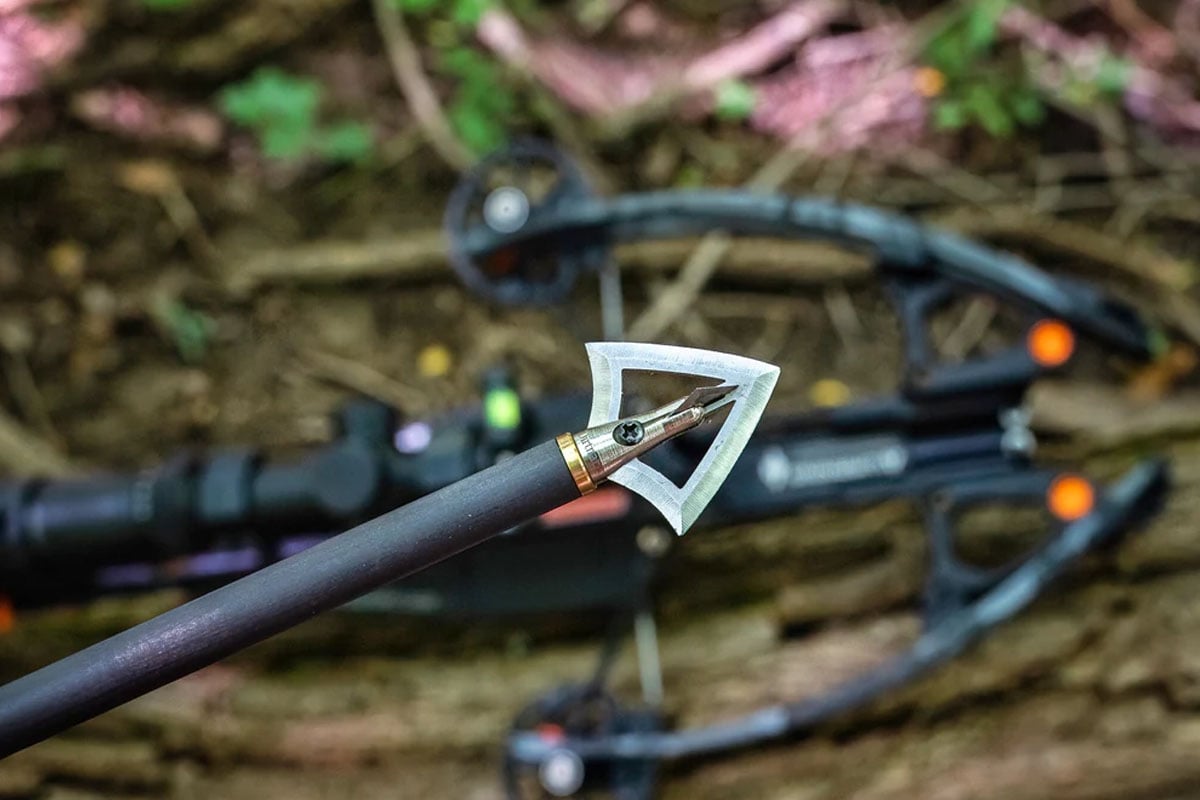
So, while you might think that your bow is the most important part of your bow/arrow/broadhead system, the truth is that your broadhead is far more important than your bow. After all, it's your broadhead that causes the fatal injury to the animal; not your bow or your arrow.
However, bowhunting elk can present a hunter with some difficult situations because shots are often taken at long ranges in windy conditions at difficult angles. Therefore, because you are likely to only get one shot at an elk, you need to have a broadhead that is extremely accurate, and which is capable of penetrating tough hide as well as rib and shoulder bones without breaking while still remaining sharp.
In fact, when hunting elk, it is imperative that your arrow has enough inertia (not kinetic energy) to completely pass through the elk's body because an elk will bleed out and die much more quickly from an entrance and exit wound than they will from an entrance wound only. Consequently, in order to gain enough penetration, most western bow hunters prefer broadheads which weigh 150 or 175 grains. However, this may not be heavy enough to enable you to achieve the goal of 8 to 10 grains of arrow weight per pound of draw weight and thus, weighted screw-in inserts are also available which will replace your standard inserts in order to enable you to reach the goal of 8 to 10 grains per pound.
Another factor to consider is whether to use fixed blade or mechanical broadheads. Here again, I will refrain from entering the debate over the pros and cons of each and I will instead say that most experienced western bow hunters prefer fixed blade broadheads over mechanical broadheads when bowhunting elk because they believe that fixed blade broadheads penetrate more deeply. In addition, most western bowhunters choose broadheads with a cutting diameter of 7/8 inches to 1 1/4 inches because broadheads with a narrower cutting diameter penetrate more deeply that those with wider cutting diameters do.
Last, you should look for a broadhead with the smoothest transition between the tip, the ferrule, and the arrow shaft because broadheads with smoother transitions will penetrate more deeply than those with steep or sharp angles.
Shot Placement for Bow Hunting Elk
Key to taking down and harvesting an elk is shot placement. Elk are big robust animals and anything but an ethical, effective kill shot should be avoided. There are several lethal shots that can be made, but not every lethal shot is an ethical shot. To harvest your elk in the cleanest most humane way possible I recommend one of the following shots. You'll want to familiarize yourself with each shot, when to take it and what to expect when the shot hits its mark.
Frontal Shot
The Frontal Shot is one of the most effective and ethical shots for taking down a bull elk. It can be a little more difficult to get off this type of shot but when made correctly it's very lethal. When the hunter hits the mark, this shot can take down a bull in just seconds. As one of the more challenging placements, I recommend being within 20-30 yards to attempt a frontal shot, unless you're an excellent marksman. If you're using a traditional or recurve bow, you will likely need to be even closer.
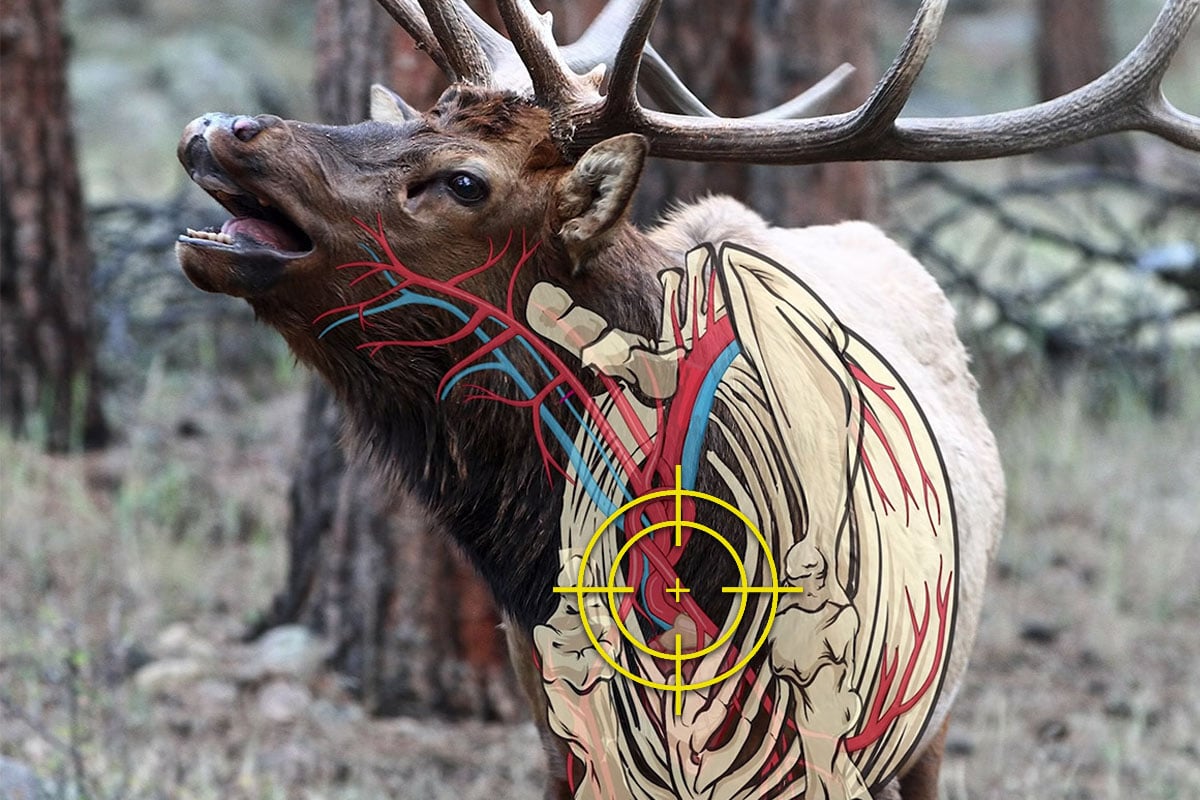
Golden Triangle Shot
The Golden Triangle Shot is also lethal if made correctly. The difficulty with this shot is that it requires pinpoint accuracy. Too high, too low, or too far to the left and you're going to hit bone, and end up having a wounded elk that may not die for several days, if at all. With this shot you're aiming for the heart just above the leg bone and to the right of the humorous. The nice thing about this shot is that if you hit just above the heart you'll end up with a double lung hit which is also a deadly shot.
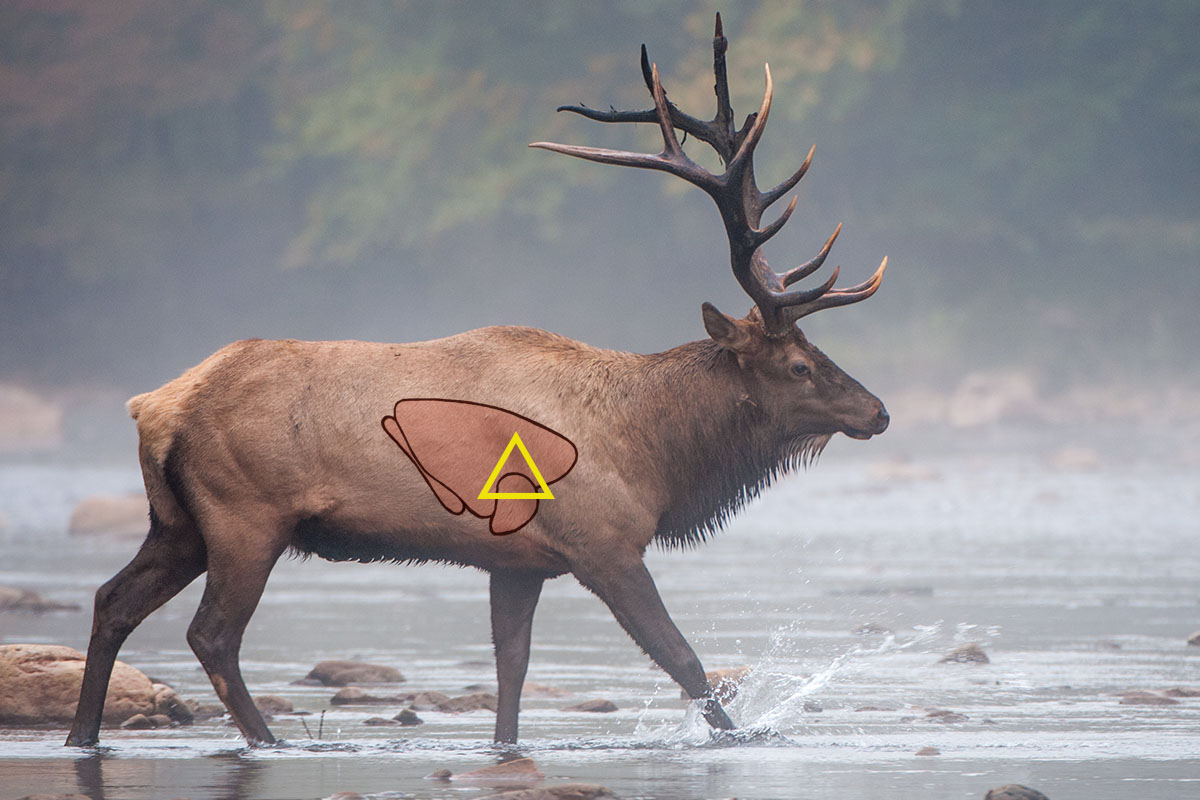
Double Lung Shot
The Double Lung shot is probably the most common kill shot for harvesting an elk. As the name suggests your goal here is to penetrate both lungs with your broadhead. To make this shot, aim mid body about 3-5 inches back from the crease (the vertical line coming up from the elbow.) One the things I like about this shot is that if you're off just a little you're still likely to take down the elk. The Double Lung Shot doesn't have quite the take down power as a Frontal or Golden Triangle shot, but it's an easier shot to take and gets the job done humanely and effectively.

Quartering Away Shot
It's not always possible to get an elk into the perfect position for the perfect shot. Sometimes you'll be forced to take your shot when the elk is quartering away. You want to be careful when taking a quartering away shot and if the animal is not a good position, don't take the shot. Again, we want a quick, humane kill.
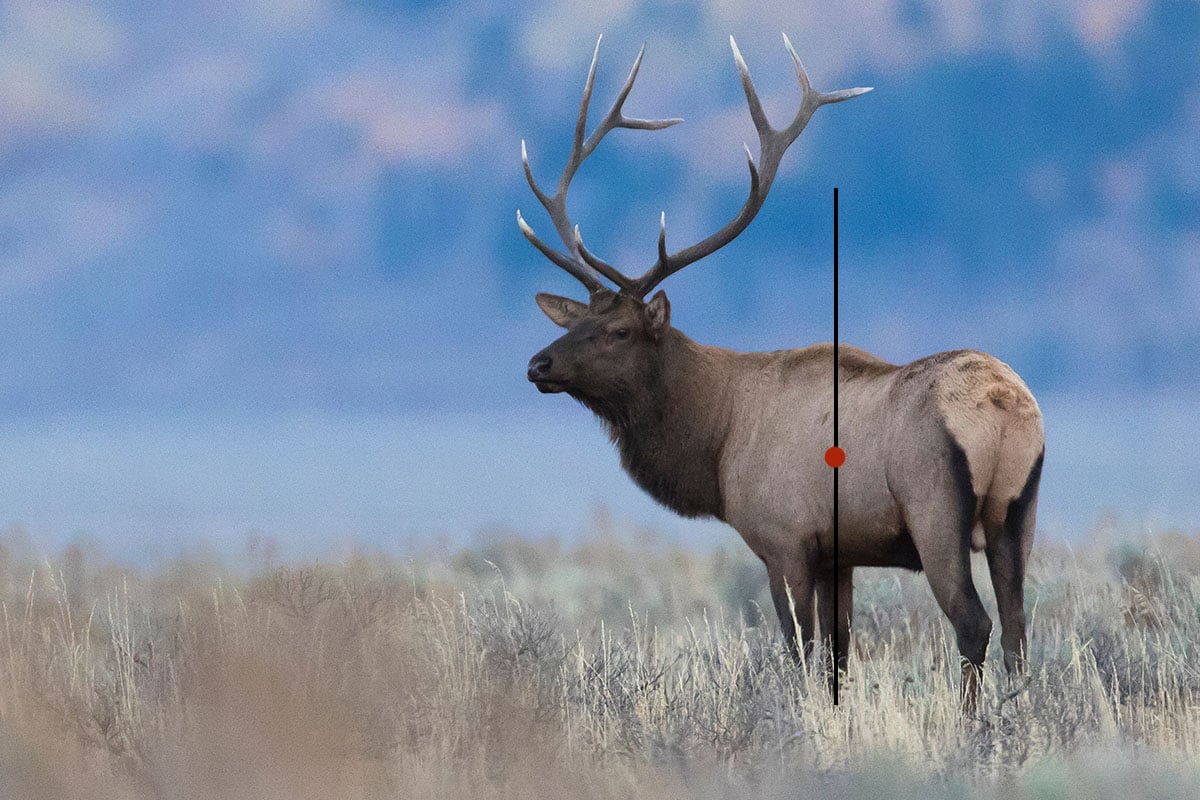
When taking a quartering shot there is little room for error. To make the quartering shot successfully, it's imperative you're familiar with the elk's anatomy. With a quartering away shot your goal is deep penetration into vital organs including the lungs. Your priority should be to get off a successful double lung shot.
A quartering away shot is not the same as a quartering toward shot. I highly recommend not attempting to shoot an elk using a bow when its quartering toward you. There just too high a probability you'll hit bone instead of the heart or lungs.
Conclusion
If you have read my guide on hunting eastern whitetail deer, you are now aware that eastern whitetail deer habitat is vastly different from western elk habitat and thus, drastically different tactics are required to hunt elk in the west from those used to hunt whitetail deer in the east. In fact, most everything about it is different from sitting on a hilltop glassing for hours on end instead of sitting in a tree stand for hours on end to size of the animals and the range at which they are most often shot.
Furthermore, the gear that you choose when hunting elk is far more critical than the gear you choose when hunting whitetail deer because elk are so much larger and tougher than whitetail deer are. But, by using the tactics and tips that I have provided above and by adjusting both your gear and your tactics accordingly as well as using Google Earth to familiarize yourself with your parcel before you ever step foot on it, you just might get a chance at harvesting a mature bull elk.